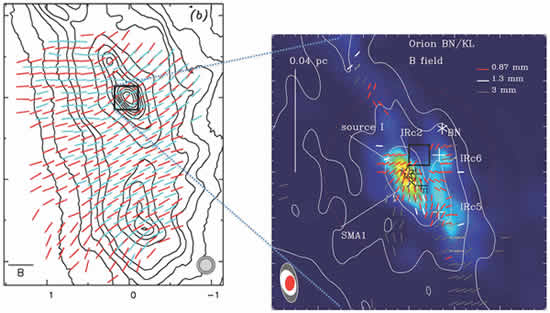Research Gallery > The SAO/ASIAA Submillimeter Array (SMA)
Research Gallery
The SAO/ASIAA Submillimeter Array (SMA)
| Magnetic field structure of Orion BN/KL |
|
Image Credit: Tang et al.

Left - Maps of magnetic field in OMC1 region observed with the CSO at 0.35 mm (red) and 0.45 mm (blue). Continuum intensity at 0.35 mm is shown as black contours. Right - Maps of magnetic field in the Orion BN/KL region observed with the SMA at 0.87 mm (red) and with BIMA at 1.3 mm (white) and 3mm (grey). Continuum emission at 0.87 mm is shown in both contours and color scale.
|
| Magnetic fields play an important role in star formation, and the SMA can be used to infer their detailed distribution in star-forming regions by observing polarized dust continuum emission at high resolution. Figure 8 shows the magnetic fields in OMC1, which is a molecular cloud behind Orion M42. The large scale magnetic fields in the OMC1 are uniform and perpendicular to the ridge. On the other hand, if we zoom in to the most prominent peak called Orion BN/KL, the magnetic fields start to show azimuthally symmetric structure. The field directions are pointing toward 2.5” west of the center of explosive outflows, indicating that the pattern of the magnetic field is correlated with the outflows. (Tang et al. 2010, ApJ, 717, 1262). |
 asiaa.sinica.edu.tw Media Request: epo
asiaa.sinica.edu.tw Media Request: epo asiaa.sinica.edu.tw
asiaa.sinica.edu.tw 